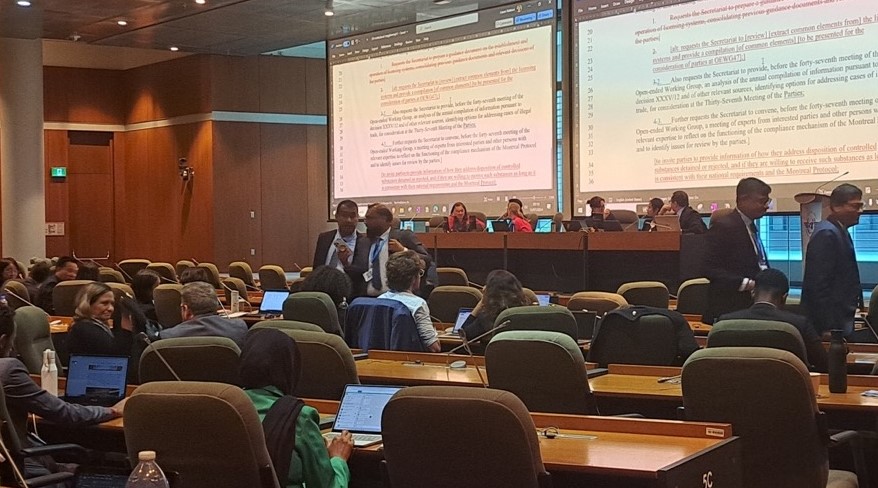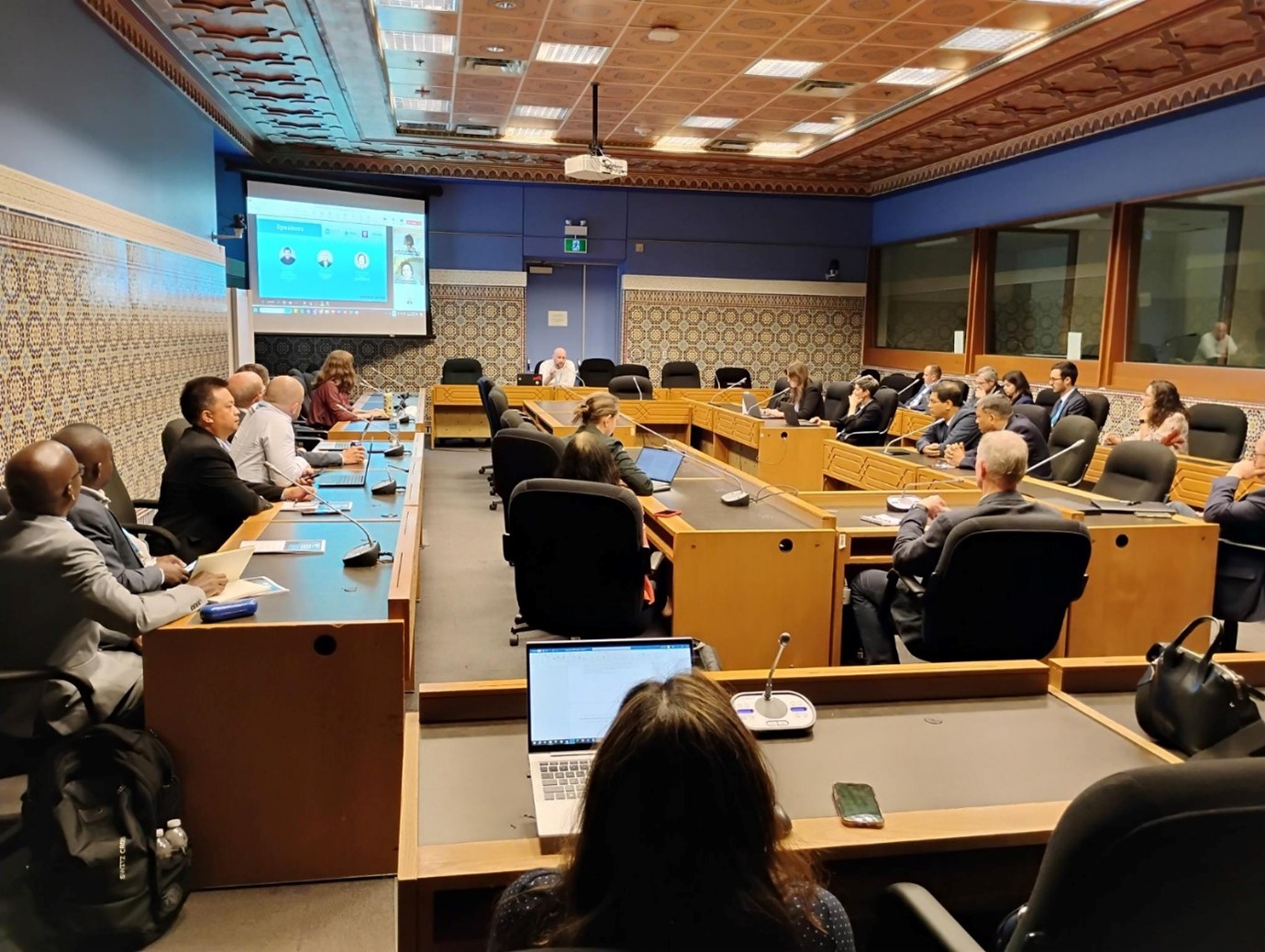Identifying opportunities to the strengthen the world’s most successful environmental treaty



The Montreal Protocol was created in 1987 to regulate the chemicals responsible for destroying the ozone layer and in 2016 its scope was expanded to include hydrofluorocarbons (HFCs), which are potent greenhouse gases.
Last week, Parties to the Montreal Protocol met in Canada in the treaty’s home city for the 46th Open-Ended Working Group (OEWG46) to consider a range of important issues related to the protection of the ozone layer and global climate system.
Following the meeting, nine draft decisions will now move ahead to the 36th Meeting of Parties (MoP36) in Bangkok, Thailand where negotiations will continue in October and decisions affecting the future of the Protocol will be made.
These draft decisions address a broad range of topics, including energy efficiency, institutional strengthening and enhanced atmospheric monitoring.
Parties made significant progress at OEWG46, demonstrating a collective will to make progress and find common ground, particularly in relation to enhancing regional atmospheric monitoring and improving energy efficiency in the cooling sector.
However, efforts to build consensus in other areas did not go as smoothly and several vital decisions – including those related to strengthening and feedstock uses of controlled substances (a significant, but currently permitted source of ozone-depleting and climate-damaging emissions) – will remain contentious when negotiations resume later this year.

Opening of the OEWG46 meeting (c) Ozone Secretariat
For several years, there has been a broad recognition of the need to enhance global and regional atmospheric monitoring under the Montreal Protocol. The unexpected emissions of ozone-destroying CFC-11 reported in 2018 (which led to EIA’s discovery of illegal production taking place in China) were a stark reminder of the important role monitoring plays in ensuring compliance with the Protocol and the CFC-11 scandal drew attention to the remaining gaps in the global atmospheric monitoring network.
Reflecting the acknowledged need, Parties at OEWG46 were not discussing whether regional atmospheric monitoring should be enhanced, but rather how this enhancement should be funded. At the meeting, Parties reached broad agreement that funds should be made available for projects to begin evaluating the suitability of potential monitoring sites, a significant step towards a more complete, more effective monitoring network.
Considering how energy-intensive the cooling sector can be, it is unsurprising that energy efficiency has become something of a watchword at the Montreal Protocol in recent years.
Early in last week’s meeting, when the topic of energy efficiency first came up, several Parties expressed support for the creation of a funding window under the Multilateral Fund (MLF) to help Article 5 (developing) countries fund energy efficiency projects.
A draft decision on the topic was put forward later in the week that picked up on this idea, and also proposed the establishment of regional centres of excellence for energy efficiency, following a capacity-building model that is already showing promise in other areas of the Montreal Protocol’s work.
The Montreal Protocol is often referred to as the world’s “most successful environmental treaty”, but maintaining this accolade and protecting the Protocol’s legacy requires Parties to engage critically with the elements of the treaty that don’t function as effectively as they should. The topic of institutional strengthening is therefore of vital importance.
Following the exposure of illegal CFC-11 production in 2018, Parties made a commitment to ensure the sustainability of the treaty’s decisions and controls. We are now six years on from this scandal and Parties have failed to take steps to achieve this, despite a series of opportunities.
The most recent of these opportunities before last week’s OEWG46 meeting, was a half-day workshop in 2023, which was used to produce a list of suggested elements to be included in draft decisions on the topic. Among others, these suggested elements included:
At OEWG46, the EU put forward a draft decision that sought to address at least some of these elements, focusing in particular on licensing and quota systems, illegal trade and compliance.
Discussions revealed significant differences between Parties, some expressing support for a review of the treaty’s institutions and its approaches to illegal trade and compliance, while others argued that the current processes remain sufficiently effective, rendering the draft decision unnecessary.
EIA believes a comprehensive review of the Protocol’s institutions, and particularly its compliance mechanism, is long overdue. Support for the draft decision is a positive step, but we hope efforts are made to discuss this important issue before October so an effective decision can be reached.
EIA recently wrote a paper outlining our vision for addressing the Montreal Protocol’s shortcomings and strengthening it for the future — that paper, More to Offer from the Montreal Protocol was published in the Journal of Integrated Environmental Sciences.

Contact group discussions during the OEWG46 meeting (c) Ozone Secretariat
Also discussed at OEWG46 were very short-lived substances (VSLS) and feedstock uses of controlled substances.
VSLS are substances that do not last long in the atmosphere, typically remaining there less than six months. Although VSLS have less opportunity to harm the ozone layer, there is growing evidence that the harm they do cause is still significant. Despite this growing evidence however, VSLS are still relatively poorly understood and Parties have not yet taken any action to control them under the Protocol. To address this knowledge gap, a draft decision put forward by Australia, Switzerland and the EU to request that the Protocol’s expert panels gather further research.
Feedstocks, meanwhile, are chemicals used as ‘building blocks’ in the manufacture of other substances. Feedstocks are another source of ozone-depleting and climate-damaging emissions which are not yet controlled under the Protocol, even though the substances used as feedstocks would be controlled for any other uses. This is because, when the feedstock exemption was agreed, it was thought the chemicals used as feedstocks would be completely consumed during the manufacturing process and so would not cause significant emissions. There is now very strong evidence this assumption was incorrect — EIA has estimated annual feedstock emissions are as high as 197 million tonnes of CO2-equivalent, more than the annual greenhouse gas emissions reported by 170 of the world’s countries in 2022.
Among other things, the draft decision on feedstocks at OEWG46 urged Parties to adopt best practices and minimise their feedstock emissions, while requesting the MLF to consider ways funding could be provided to support Article 5 countries to do this.
To find out more about the issue of VSLS and feedstocks, as well as the other topics discussed at OEWG46, you can read EIA’s briefing to Parties.
To round off on a positive note, EIA ran a side event at OEWG46 on controlling industrial nitrous oxide (N2O) emissions under the Montreal Protocol with guest speakers Professor David Kanter (New York University & International Nitrogen Initiative) and Volker Schmidt (Nitric Acid Climate Action Group).
Although it is the world’s most prevalent ozone-depleting substance (and third most significant greenhouse gas), N2O is shockingly still not subject to any controls under the Protocol.
You can find out more about industrial emissions of this super pollutant – and the role the Montreal Protocol could play in preventing them – in our latest briefing, Taking Industrial Action.

EIA’s side event ‘Controlling industrial emissions of N2O under the Montreal Protocol’ (c) EIA